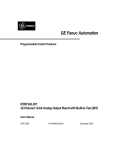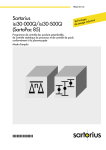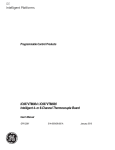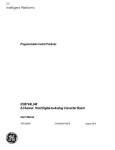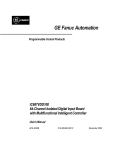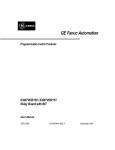Download 12-bit Analog Output Board User`s Manual, GFK-2078A
Transcript
Programmable Control Products IC697VAL306 12-bit Analog Output Board User’s Manual GFK-2078A 514-000443-000 C August 2010 GFL-002 Warnings, Cautions, and Notes as Used in this Publication Warning Warning notices are used in this publication to emphasize that hazardous voltages, currents, temperatures, or other conditions that could cause personal injury exist in this equipment or may be associated with its use. In situations where inattention could cause either personal injury or damage to equipment, a Warning notice is used. Caution Caution notices are used where equipment might be damaged if care is not taken. Note: Notes merely call attention to information that is especially significant to understanding and operating the equipment. This document is based on information available at the time of its publication. While efforts have been made to be accurate, the information contained herein does not purport to cover all details or variations in hardware or software, nor to provide for every possible contingency in connection with installation, operation, or maintenance. Features may be described herein which are not present in all hardware and software systems. GE Intelligent Platforms assumes no obligation of notice to holders of this document with respect to changes subsequently made. GE Intelligent Platforms makes no representation or warranty, expressed, implied, or statutory with respect to, and assumes no responsibility for the accuracy, completeness, sufficiency, or usefulness of the information contained herein. No warranties of merchantability or fitness for purpose shall apply. * indicates a trademark of GE Intelligent Platforms, Inc. and/or its affiliates. All other trademarks are the property of their respective owners. ©Copyright 2010 GE Intelligent Platforms, Inc. All Rights Reserved Contact Information If you purchased this product through an Authorized Channel Partner, please contact the seller directly. General Contact Information Online technical support and GlobalCare http://www.ge-ip.com/support 1H2 Additional information http://www.ge-ip.com/ 3H Solution Provider [email protected] 4H Technical Support If you have technical problems that cannot be resolved with the information in this guide, please contact us by telephone or email, or on the web at www.ge-ip.com/support 5H Americas Online Technical Support www.ge-ip.com/support 6H7 Phone 1-800-433-2682 International Americas Direct Dial 1-780-420-2010 (if toll free 800 option is unavailable) Technical Support Email [email protected] 8H9 Customer Care Email Primary language of support [email protected] 10H English Europe, the Middle East, and Africa Online Technical Support www.ge-ip.com/support 12H3 Phone +800-1-433-2682 EMEA Direct Dial +352-26-722-780 (if toll free 800 option is unavailable or if dialing from a mobile telephone) Technical Support Email [email protected] 14H5 Customer Care Email Primary languages of support [email protected] 16H7 English, French, German, Italian, Czech, Spanish Asia Pacific Online Technical Support www.ge-ip.com/support Phone 18H9 +86-400-820-8208 +86-21-3217-4826 (India, Indonesia, and Pakistan) Technical Support Email [email protected] (China) 20H1 [email protected] (Japan) 2H3 [email protected] (remaining Asia customers) 24H5 Customer Care Email [email protected] 26H7 [email protected] (China) 28H UL Information 1. EQUIPMENT LABELED WITH REFERENCE TO CLASS I, Div. 2, GROUPS A, B, C & D HAZARDOUS LOCATIONS IS SUITABLE FOR USE IN CLASS I, ZONE 2, GROUPS A, B, C, D OR NON-HAZARDOUS LOCATIONS ONLY. 2. EQUIPMENT LABELED WITH REFERENCE TO CLASS I, ZONE 2, GROUPS A, B, C & D HAZARDOUS LOCATIONS IS SUITABLE FOR USE IN CLASS I, ZONE 2, GROUPS A, B, C, D OR NON-HAZARDOUS LOCATIONS ONLY. 3. WARNING – EXPLOSION HAZARD – SUBSTITUTION OF COMPONENTS MAY IMPAIR SUITABILITY FOR CLASS I, DIVISION 2. 4. WARNING – EXPLOSION HAZARD – DO NOT DISCONNECT EQUIPMENT UNLESS POWER HAS BEEN SWITCHED OFF OR THE AREA IS KNOWN TO BE NON-HAZARDOUS. Contents Chapter 1 Introduction, Description, and Specifications ......................................... 1-1 Reference Material and Other GE Manuals.............................................................. 1-1 General Description ................................................................................................. 1-2 Functional Description ............................................................................................. 1-3 Safety Summary ....................................................................................................... 1-4 Chapter 2 Configuration and Installation.................................................................. 2-1 Physical Installation ................................................................................................. 2-2 Before Applying Power: Checklist ......................................................................... 2-3 Operational Configuration ....................................................................................... 2-4 Calibration................................................................................................................ 2-8 Connector Descriptions .......................................................................................... 2-18 Chapter 3 Programming.............................................................................................. 3-1 Introduction to Programming the 12-bit Analog Output Board ............................... 3-2 Control and Status Register Description .................................................................. 3-3 Initialization ............................................................................................................. 3-4 Controlling the Analog Outputs ............................................................................... 3-6 Chapter 4 Theory of Operation .................................................................................. 4-1 Functional Organization........................................................................................... 4-2 VMEbus Control Interface ....................................................................................... 4-3 Analog Outputs ........................................................................................................ 4-5 Built-in-Power Converter......................................................................................... 4-8 Board ID Register .................................................................................................... 4-9 Chapter 5 GFK-2078A Maintenance................................................................................................ 5-1 iv Chapter Introduction, Description, and Specifications 1 This manual describes the installation and operation of the IC697VAL306 12-bit Analog Output Board. Reference Material and Other GE Manuals For a detailed explanation of the VMEbus and its characteristics, the publication “The VMEbus Specification” is available from: VITA VMEbus International Trade Association 7825 East Gelding Dr., No. 104 Scottsdale, AZ 85260 (480) 951-8866 FAX: (480) 951-0720 Internet: www.vita.com The following Application and Configuration Guides are available from GE to assist in the selection, specification, and implementation of systems based upon GE’s products: GFK-2078A Analog I/O Products (Built-in-Test) Configuration Guide (catalog number GFK-2084) Provides assistance in configuring analog I/O subsystems based on GE’s analog I/O products, including common designs, which offer a wide variety of solutions. Connector and I/O Cable Application Guide (catalog number GFK-2085) Describes I/O connections that can be used with GE’s VMEbus products. Includes connector compatibility information and examples. 1-1 1 General Description The 12-bit Analog Output Board provides 16 high-quality analog output channels. These channels are jumper-selectable for voltage outputs, current loop outputs, or a combination of voltage and current loop outputs. Each output current range is also jumper-selectable. On-board ±15 V DC-toDC converters are used to supply ±15 V. The following brief overview of principal features illustrates the flexibility and the performance that is available with the 12-bit Analog Output Board: 1-2 • 16 analog output channels • Jumper-selectable voltage or current outputs • 12-bit DAC resolution • Output current ranges of 4 to 20 mA, 0 to 20 mA, and 5 to 25 mA (4 to 12 mA, 0 to 10 mA, and 5 to 15 mA are also available) • Output voltage ranges of ± 2.5 V, ± 5.0 V, ± 10 V, 0 to + 10 V, and 0 to + 5 V • Output short-circuit protection • Front panel outputs (P3) • Front panel Fail LED indicator • Double height Eurocard form factor IC697VAL306 12-bit Analog Output Board User’s Manual – August 2010 GFK-2078A 1 Functional Description Each of the 16 channels in the self-contained, 12-bit Analog Output Board is programmable by the user via 16 12-bit RAM locations. Each RAM location corresponds to an output channel. The 12bit Analog Output Board periodically fetches the 12-bit binary values out of the RAM locations and uses them as the inputs to the on-board DAC. The output of the DAC is distributed to the sample-and-hold circuits associated with each output channel. Figure 1-1: 12-bit Analog Output Board Functional Block Diagram VMEbus CONN. P1 ADDRESS SELECTION ADDRESS MODIFIERS ADDRESS CONTROL LOGIC VMEbus ADDRESS MODIFIER AND ADDRESS DECODER FAIL LED FRONT PANEL P3 RAM REFRESH BUS DATA BUS V0 VMEbus DATA BUS TRANSCEIVER DATA STORAGE RAM 12-BIT DAC S&H0 OUTPUT SWITCH S&H15 OUTPUT SWITCH V I DEMULTIPLEXER I0 V0 V I I0 CONTROL BUFFERS ±15 V +5 V DC-to-DC CONVERTERS ±15 V P2 EXT ±15 V GFK-2078A Chapter 1 Introduction, Description, and Specifications 1-3 1 Safety Summary The following general safety precautions must be observed during all phases of this operation, service, and repair of this product. Failure to comply with these precautions or with specific warnings elsewhere in this manual violates safety standards of design, manufacture, and intended use of this product. GE assumes no liability for the customer’s failure to comply with these requirements. Ground the System To minimize shock hazard, the chassis and system cabinet must be connected to an electrical ground. A three-conductor AC power cable should be used. The power cable must either be plugged into an approved three-contact electrical outlet or used with a three-contact to two-contact adapter with the grounding wire (green) firmly connected to an electrical ground (safety ground) at the power outlet. Do Not Operate in an Explosive Atmosphere Do not operate the system in the presence of flammable gases or fumes. Operation of any electrical system in such an environment constitutes a definite safety hazard. Keep Away from Live Circuits Operating personnel must not remove product covers. Component replacement and internal adjustments must be made by qualified maintenance personnel. Do not replace components with power cable connected. Under certain conditions, dangerous voltages may exist even with the power cable removed. To avoid injuries, always disconnect power and discharge circuits before touching them. Do Not Service or Adjust Alone Do not attempt internal service or adjustment unless another person, capable of rendering first aid and resuscitation, is present. Do Not Substitute Parts or Modify System Because of the danger of introducing additional hazards, do not install substitute parts or perform any unauthorized modification to the product. Return the product to GE for service and repair to ensure that safety features are maintained. 1-4 IC697VAL306 12-bit Analog Output Board User’s Manual – August 2010 GFK-2078A Chapter Configuration and Installation 2 This chapter, divided into the following sections, provides configuration and installation instructions for the 12-bit Analog Output Board: Physical Installation Before Applying Power: Checklist Operational Configuration Calibration Connector Descriptions Caution Some of the components assembled on GE’s products may be sensitive to electrostatic discharge and damage may occur on boards that are subjected to a high energy electrostatic field. Unused boards should be stored in the same protective boxes in which they were shipped. When the board is to be laid on a bench for configuring, etc., it is suggested that conductive material be inserted under the board to provide a conductive shunt. Upon receipt, any precautions found in the shipping container should be observed. All items should be carefully unpacked and thoroughly inspected for damage that might have occurred during shipment. The board(s) should be checked for broken components, damaged printed circuit board(s), heat damage, and other visible contamination. All claims arising from shipping damage should be filed with the carrier and a complete report sent to GE together with a request for advice concerning the disposition of the damaged item(s). GFK-2078A 2-1 2 Physical Installation Caution Do not install or remove boards while power is applied. De-energize the equipment and insert the board into an appropriate slot of the chassis. While ensuring that the board is properly aligned and oriented in the supporting card guides, slide the board smoothly forward against the mating connector until firmly seated. 2-2 IC697VAL306 12-bit Analog Output Board User’s Manual – August 2010 GFK-2078A 2 Before Applying Power: Checklist Before installing the board in a VMEbus system, check the following items to ensure that the board is ready for the intended application. GFK-2078A • Have the chapters pertaining to programming and theory, chapters 3 and 4, been reviewed and applied to system requirements? • Review “Factory Installed Jumpers” on page 2-4 and Table 2-1 on page 2-5 to verify that all factory installed jumpers are in place. To change the board address or address modifier response, refer to “Board Address and Address Modifier Selection” on page 2-4. • Have the I/O cables, with the proper mating connectors, been connected to the input/output connector P3? Refer to “Connector Descriptions” on page 2-18 for a description of the P3 connector. • Calibration has been performed at the factory. If recalibration should be required, refer to “Calibration” on page 2-8. Chapter 2 Configuration and Installation 2-3 2 Operational Configuration Control of the 12-bit Analog Output Board address and I/O access mode are determined by field replaceable, on-board jumpers. This section describes the use of these jumpers, and their effects on board performance. The locations and functions of all 12-bit Analog Output Board jumpers are shown in Figure 2-1 on page 2-6 and Table 2-1 on page 2-5, respectively. Factory Installed Jumpers Each 12-bit Analog Output Board is configured at the factory with the specific jumper arrangement shown in Table 2-1 on page 2-5. The factory configuration establishes the following functional baseline for the 12-bit Analog Output Board, and ensures that all essential jumpers are installed. • Board short address is set at 0000 HEX • I/O access mode is short nonprivileged • Current loop outputs on all channels • 4 to 20 mA current range on all channels Board Address and Address Modifier Selection Jumper J20, and jumpers J22 and J23 permit the 12-bit Analog Output Board to be located on any 64-byte boundary within the short I/O address space. The short I/O address space consists of all addresses between NNNN0000 HEX* and NNNNFFFF HEX, and requires that 15 (word) address lines be decoded in order to account for all locations. Since five lines are used for decoding onboard functions (A1 through A5), the 12-bit Analog Output Board address is defined by ten lines; address bits A06 through A15. The board address is programmed by installing shorting plugs at all "zero" or LOW address bit jumper positions, and by omitting the shorting plugs at the "one" or HIGH positions. Address bit A06 has a weight of 64-byte locations. As an example, the jumper arrangement shown in Table 2-2 on page 2-7 would produce a board address of NNNN8840 HEX. I/O access mode is programmed by selecting address modifier AM2 with jumper J21. Short supervisory access is selected by omitting the jumper. Short nonprivileged access is selected by installing the jumper. * The value NNNN depends on the make and model of CPU board used. 2-4 IC697VAL306 12-bit Analog Output Board User’s Manual – August 2010 GFK-2078A 2 Table 2-1: Programmable Jumper Functions Jumper Function Factory Configured ** J20 – 1, 2 Board Address Bit A15 = 0 Installed J20 – 3, 4 Board Address Bit A14 = 0 Installed J20 – 5, 6 Board Address Bit A13 = 0 Installed J20 – 7, 8 Board Address Bit A12 = 0 Installed J20 – 9, 10 Board Address Bit A11 = 0 Installed J20 – 11, 12 Board Address Bit A10 = 0 Installed J20 – 13, 14 Board Address Bit A09 = 0 Installed J20 – 15, 16 Board Address Bit A08 = 0 Installed J23 – 1, 2 Board Address Bit A07 = 0 Installed J22 – 1, 2 Board Address Bit A06 = 0 Installed J21 – 1, 2 Short Supervisory Access Omitted J19 – 1, 2 “8 CH L” (Not Used) Omitted J18 – 1, 2 Unipolar Operation Installed J18 – 2, 3 Bipolar Operation Omitted J17 – 1, 2 * 10 V Full Scale Range Installed J17 – 2, 3 * 5 V Full Scale Range Omitted J1 through J16 See Figure 2-2 on page 2-8 * The J17 jumper is omitted for the 20 V FSR. ** The factory configuration shown is for the -000 option of the 12-bit Analog Output Board. GFK-2078A Chapter 2 Configuration and Installation 2-5 2-6 2 * J1 J3 * J4 * J5 * J6 * J7 * * J9 * J10 * J11 * R26 R27 R28 R29 A1 R36 R37 R38 R39 TP2 R42 R43 R44 R45 J19 R52 R53 R54 R55 R58 R59 R60 R61 AM2 J21 A08 16 * ** R68 R69 R70 R71 15 J20 R74 R75 R76 R77 GFK-2078A P2 2 A15 * * J16 R20 R21 R22 R23 * J15 * J14 R13 * J13 * J12 A2 R7 T P1 * J8 J17 J18 R1 J23 A07 1 P1 A06 J22 Figure 2-1: Locations of Programmable Jumpers, Adjustment Potentiometer, and Test Points * * Denotes Pin 1 Orientation IC697VAL306 12-bit Analog Output Board User’s Manual – August 2010 J2 * * P3 2 Table 2-2: Example Board Address (NNNN9980 HEX) Selection Jumper Address Bit State * J22 – 1, 2 A06 Open J23 – 1, 2 A07 Shorted J20 – 15, 16 A08 Shorted J20 – 13, 14 A09 Shorted J20 – 11, 13 A10 Shorted J20 – 9, 10 A11 Open J20 – 7, 8 A12 Shorted J20 – 5, 6 A13 Shorted J20 – 3, 4 A14 Shorted J20 – 1, 2 A15 Open * Shorted = “zero” (Jumper installed). Open = “one”. Analog Voltage Output Mode Figure 2-2 on page 2-8 shows how to configure each individual channel for voltage output mode. Output Voltage Range Output voltage range is controlled by jumper J17. The maximum full scale range is 20 V. To modify the full scale range to 10 V or 5 V, configure jumper J17 as indicated in Table 2-1 on page 2-5. The 20 V full scale range is selected by omitting the J17 jumper entirely. Bipolar or Unipolar Operation Bipolar or Unipolar operation of the analog voltage outputs is selected with jumper J18, as indicated in Table 2-1 on page 2-5. Analog Current Output Mode Figure 2-2 on page 2-8 shows how to configure each individual channel for current output mode at any of the specified ranges. In order to produce current loop outputs, the voltage outputs must be configured for unipolar operation. Typically the voltage range is set to 0 to +10 V to produce 4 to 20 mA, 0 to 20 mA or 5 to 25 mA. A voltage range of 0 to +5 V can be selected to produce 4 to 12 mA, 0 to 10 mA or 5 to 15 mA. GFK-2078A Chapter 2 Configuration and Installation 2-7 2 Calibration Before delivery from the factory, the 12-bit Analog Output Board is fully calibrated and conforms to all specifications. Should recalibration be required, however, perform the procedures in “Analog Outputs Calibration Procedure” on page 2-10 with the equipment listed in “Equipment Required” on page 2-9. The locations of all adjustments and test points are shown in Figure 2-1 on page 2-6. Adjustment potentiometers and their functions are listed in the Table 2-3 on page 2-9. As delivered from the factory, all calibration adjustments are sealed against accidental movement. The seals are easily broken for recalibration, however. All adjustments should be resealed with a suitable fast-curing sealing compound after recalibration has been completed. Caution Do not install or remove this board with power applied to the system. Figure 2-2: Output Channel Jumper Configurations - Jumper Connections for J1 through J16 1 2 V OUT I OUT 1 2 3 (0 to 20mA) 4 5 6 7 8 9 1 2 3 4 5 6 7 8 9 3 I OUT 4 5 6 7 8 9 1 2 3 4 5 6 (4 to 20mA) I OUT (5 to 20mA) 7 8 9 Factory Configured 2-8 IC697VAL306 12-bit Analog Output Board User’s Manual – August 2010 GFK-2078A 2 Table 2-3: Adjustment Potentiometer Functions Channel Number Zero Adjust Span Adjust 0 R21 R20 1 R23 R22 2 R27 R26 3 R29 R28 4 R37 R36 5 R39 R38 6 R43 R42 7 R45 R44 8 R53 R52 9 R55 R54 10 R59 R58 11 R61 R60 12 R69 R68 13 R71 R70 14 R75 R74 15 R77 R76 R1 Bipolar Outputs Zero Adjust R7 Outputs Gain Adjust R13 Unipolar Outputs Zero Adjust Current Adjustments Voltage Adjustments Equipment Required GFK-2078A • Digital Multimeter (DMM) – ±1.0000 VDC and ±10.000 VDC ranges; 5 or more digits; ±0.005 percent of reading voltage measurement accuracy; 10 MΩ minimum input impedance. Current measurements at 1 µA resolution; 5 or more digits. • Chassis – VMEbus backplane or equivalent, J1 and J2 connectors, VMEbus master controller, +5 ±0.1 VDC, power supply. One slot allocated for testing the 12-bit Analog Output Board. • Extender board – VMEbus extender board. • Test cables – Test cables for the equipment listed above. Chapter 2 Configuration and Installation 2-9 2 Analog Outputs Calibration Procedure The following sections provide detailed calibration procedures for all of the voltage/current ranges provided by the 12-bit Analog Output Board. Calibration Procedure for 0 to 10 V Output Range Calibration Procedure for 0 to 5 V Output Range Calibration Procedure for ± 2.5 V Output Range Calibration Procedure for ± 5.0 V Output Range Calibration Procedure for ± 10.0 V Output Range Calibration Procedure for 4 to 20 mA Output Range Calibration Procedure for 0 to 20 mA Output Range Calibration Procedure for 5 to 25 mA Output Range The following procedures are performed with the FAIL LED L bit set to a "one", the TWO'S COMPL L bit set to a "one", and the FAST REFRESH H bit set to a "zero" in the CSR. Note Calibration of outputs to a specific range does not necessarily mean that if the jumpers are reconfigured, this channel will still be calibrated. Calibration Procedure for 0 to 10 V Output Range Setup: 1. Install the 12-bit Analog Output Board on an extender board in a VMEbus backplane. 2. Configure all output channels for voltage outputs (see Figure 2-2 on page 2-8). 3. Configure J17 and J18 for unipolar operation and 10 V full scale range (see Table 2-1 on page 2-5). 4. Turn ON the power to the VMEbus backplane. DAC Output Adjustments: 2-10 5. Write 5800 HEX to relative address 02. 6. Connect the (+) lead of the DMM to Test Point No. 1 (TP1). Connect the (-) lead of the DMM to TP2. 7. Write 0000 to relative addresses 20 HEX through 3E HEX (i.e. the 16 decimal memory locations corresponding to the 16 output channels). 8. Adjust potentiometer R13 for a DMM indication of 0.0000 ±0.0010 VDC. 9. Write 0FFF to relative addresses 20 HEX through 3E HEX (i.e. the 16 decimal memory locations corresponding to the 16 output channels). IC697VAL306 12-bit Analog Output Board User’s Manual – August 2010 GFK-2078A 2 10. Adjust potentiometer R7 for a DMM indication of +9.9976 ±0.0010 VDC . 11. Gain adjustments (Steps 9 and 10) may appreciably alter the offset adjustment and vice versa; therefore, Steps 7 through 10 must be repeated as many times as required. 12. Calibration of the analog outputs is completed. Remove power and all test connections. Calibration Procedure for 0 to 5 V Output Range Setup: 1. Install the 12-bit Analog Output Board on an extender board in a VMEbus backplane. 2. Configure all output channels for voltage outputs (see Figure 2-2 on page 2-8). 3. Configure J17 and J18 for unipolar operation and 5 V full scale range (see Table 2-1 on page 2-5). 4. Turn ON the power to the VMEbus backplane. DAC Output Adjustments: 5. Write 5800 HEX to relative address 02. 6. Connect the (+) lead of the DMM to Test Point No. 1 (TP1). Connect the (-) lead of the DMM to TP2. 7. Write 0000 to relative addresses 20 HEX through 3E HEX (i.e. the 16 decimal memory locations corresponding to the 16 output channels). 8. Adjust potentiometer R13 for a DMM indication of 0.0000 ±0.0010 VDC. 9. Write 0FFF to relative addresses 20 HEX through 3E HEX (i.e. the 16 decimal memory locations corresponding to the 16 output channels). 10. Adjust potentiometer R7 for a DMM indication of +4.9988 ±0.0010 VDC . 11. Gain adjustments (Steps 9 and 10) may appreciably alter the offset adjustment and vice versa; therefore, Steps 7 through 10 must be repeated as many times as required. 12. Calibration of the analog outputs is completed. Remove power and all test connections. GFK-2078A Chapter 2 Configuration and Installation 2-11 2 Calibration Procedure for ± 2.5 V Output Range Setup: 1. Install the 12-bit Analog Output Board on an extender board in a VMEbus backplane. 2. Configure all output channels for voltage outputs (see Figure 2-2 on page 2-8). 3. Configure J17 and J18 for bipolar operation and 5 V full scale range (see Table 2-1 on page 2-5). 4. Turn ON the power to the VMEbus backplane. DAC Output Adjustments: 5. Write 5800 HEX to relative address 02. 6. Connect the (+) lead of the DMM to Test Point No. 1 (TP1). Connect the (-) lead of the DMM to TP2. 7. Write 0800 to relative addresses 20 HEX through 3E HEX (i.e. the 16 decimal memory locations corresponding to the 16 output channels). 8. Adjust potentiometer R1 for a DMM indication of 0.0000 ±0.0010 VDC. 9. Write 0FFF to relative addresses 20 HEX through 3E HEX (i.e. the 16 decimal memory locations corresponding to the 16 output channels). 10. Adjust potentiometer R7 for a DMM indication of +2.4988 ±0.0010 VDC . 11. Gain adjustments (Steps 9 and 10) may appreciably alter the offset adjustment and vice versa; therefore, Steps 7 through 10 must be repeated as many times as required. 12. Calibration of the analog outputs is completed. Remove power and all test connections. Calibration Procedure for ± 5.0 V Output Range Setup: 2-12 1. Install the 12-bit Analog Output Board on an extender board in a VMEbus backplane. 2. Configure all output channels for voltage outputs (see Figure 2-2 on page 2-8). 3. Configure J17 and J18 for bipolar operation and 10 V full scale range (see Table 2-1 on page 2-5). 4. Turn ON the power to the VMEbus backplane. IC697VAL306 12-bit Analog Output Board User’s Manual – August 2010 GFK-2078A 2 DAC Output Adjustments: 5. Write 5800 HEX to relative address 02. 6. Connect the (+) lead of the DMM to Test Point No. 1 (TP1). Connect the (-) lead of the DMM to TP2. 7. Write 0800 to relative addresses 20 HEX through 3E HEX (i.e. the 16 decimal memory locations corresponding to the 16 output channels). 8. Adjust potentiometer R1 for a DMM indication of 0.0000 ±0.0010 VDC. 9. Write 0FFF to relative addresses 20 HEX through 3E HEX (i.e. the 16 decimal memory locations corresponding to the 16 output channels). 10. Adjust potentiometer R7 for a DMM indication of +4.9976 ±0.0010 VDC . 11. Gain adjustments (Steps 9 and 10) may appreciably alter the offset adjustment and vice versa; therefore, Steps 7 through 10 must be repeated as many times as required. 12. Calibration of the analog outputs is completed. Remove power and all test connections. Calibration Procedure for ± 10.0 V Output Range Setup: 1. Install the 12-bit Analog Output Board on an extender board in a VMEbus backplane. 2. Configure all output channels for voltage outputs (see Figure 2-2 on page 2-8). 3. Configure J17 and J18 for bipolar operation and 20 V full scale range (see Table 2-1 on page 2-5). 4. Turn ON the power to the VMEbus backplane. DAC Output Adjustments: 5. Write 5800 HEX to relative address 02. 6. Connect the (+) lead of the DMM to Test Point No. 1 (TP1). Connect the (-) lead of the DMM to TP2. 7. Write 0800 to relative addresses 20 HEX through 3E HEX (i.e. the 16 decimal memory locations corresponding to the 16 output channels). 8. Adjust potentiometer R1 for a DMM indication of 0.0000 ±0.0010 VDC. 9. Write 0FFF to relative addresses 20 HEX through 3E HEX (i.e. the 16 decimal memory locations corresponding to the 16 output channels). 10. Adjust potentiometer R7 for a DMM indication of +9.9951 ±0.0010 VDC. 11. Gain adjustments (Steps 9 and 10) may appreciably alter the offset adjustment and vice versa; therefore, Steps 7 through 10 must be repeated as many times as required. 12. Calibration of the analog outputs is completed. Remove power and all test connections. GFK-2078A Chapter 2 Configuration and Installation 2-13 2 Calibration Procedure for 4 to 20 mA Output Range Setup: 1. Install the 12-bit Analog Output Board on an extender board in a VMEbus backplane. 2. Configure all output channels for 4 to 20 mA (see Figure 2-2 on page 2-8). 3. Configure J17 and J18 for unipolar operation and 10 V full scale range (see Table 2-1 on page 2-5). 4. Turn ON the power to the VMEbus backplane. DAC Output Adjustments: 5. Write 5C00 HEX to relative address 02. 6. Connect the (+) lead of the DMM to Test Point No. 1 (TP1). Connect the (-) lead of the DMM to TP2. 7. Write 0000 to relative addresses 20 HEX through 3E HEX (i.e. the 16 decimal memory locations corresponding to the 16 output channels). 8. Adjust potentiometer R13 for a DMM indication of 0.0000 ±0.0010 VDC. 9. Write 0FFF to relative addresses 20 HEX through 3E HEX (i.e. the 16 decimal memory locations corresponding to the 16 output channels). 10. Adjust potentiometer R7 for a DMM indication of +9.9976 ±0.0010 VDC . 11. Gain adjustments (Steps 9 and 10) may appreciably alter the offset adjustment and vice versa; therefore, Steps 7 through 10 must be repeated as many times as required. Current Output Adjustments: 12. Set the DMM for current measurements (make sure that the DMM is set to a range that provides a 1 µA or better resolution). 13. Connect the (+) lead of the DMM to "CH 0 OUT" (P3-A1). Connect the (-) lead of the DMM to "AGND" (P3-A1). See the Table 2-5 on page 2-22 for P3 connector pin assignments. 14. Write 0000 to relative address 20 HEX. See Table 3-1 on page 3-4 for the 12-bit Analog Output Board memory map. 15. Adjust potentiometer R21 (offset adjustment potentiometer) for a DMM indication of 4.000 ±0.001 mA. 16. Write 0FFF to relative addresses 20 HEX (i.e. the memory location corresponding to channel 0). 17. Adjust potentiometer R20 (span adjustment potentiometer) for a DMM indication of 19.996 ±0.002 mA. 2-14 IC697VAL306 12-bit Analog Output Board User’s Manual – August 2010 GFK-2078A 2 18. Span adjustments (Steps 16 and 17) may appreciably alter the offset adjustment and vice versa; therefore, Steps 14 through 17 must be repeated as many times as required. 19. Repeat Steps 13 through 18 for channels 1 through 15. See Table 3-1 on page 3-4 for a memory map of the 12-bit Analog Output Board. See Table 2-3 on page 2-9 for a list of all the adjustment potentiometers, their functions and associated channel numbers. 20. Calibration of the analog outputs is completed. Remove power and all test connections. Calibration Procedure for 0 to 20 mA Output Range Setup: 1. Install the 12-bit Analog Output Board on an extender board in a VMEbus backplane. 2. Configure all output channels for 0 to 20 mA (see Figure 2-2 on page 2-8). 3. Configure J17 and J18 for unipolar operation and 10 V full scale range (see Table 2-1 on page 2-5). 4. Turn ON the power to the VMEbus backplane. DAC Output Adjustments: 5. Write 5C00 HEX to relative address 02. 6. Connect the (+) lead of the DMM to Test Point No. 1 (TP1). Connect the (-) lead of the DMM to TP2. 7. Write 0000 to relative addresses 20 HEX through 3E HEX (i.e. the 16 decimal memory locations corresponding to the 16 output channels). 8. Adjust potentiometer R13 for a DMM indication of 0.0000 ±0.0010 VDC. 9. Write 0FFF to relative addresses 20 HEX through 3E HEX (i.e. the 16 decimal memory locations corresponding to the 16 output channels). 10. Adjust potentiometer R7 for a DMM indication of +9.9976 ±0.0010 VDC . 11. Gain adjustments (Steps 9 and 10) may appreciably alter the offset adjustment and vice versa; therefore, Steps 7 through 10 must be repeated as many times as required. GFK-2078A Chapter 2 Configuration and Installation 2-15 2 Current Output Adjustments: 12. Set the DMM for current measurements (make sure that the DMM is set to a range that provides a 1 µA or better resolution). 13. Connect the (+) lead of the DMM to "CH 0 OUT" (P3-A1). Connect the (-) lead of the DMM to "AGND" (P3-A1). See Table 2-5 on page 2-22 for P3 connector pin assignments. 14. Write 0001 to relative address 20 HEX. See Table 3-1 on page 3-4 for the 12-bit Analog Output Board memory map. 15. Adjust potentiometer R21 (offset adjustment potentiometer) for a DMM indication of 0.005 ±0.001 mA. 16. Write 0FFF to relative addresses 20 HEX (i.e. the memory location corresponding to channel 0). 17. Adjust potentiometer R20 (span adjustment potentiometer) for a DMM indication of 19.995 ±0.002 mA. 18. Span adjustments (Steps 16 and 17) may appreciably alter the offset adjustment and vice versa; therefore, Steps 14 through 17 must be repeated as many times as required. 19. Repeat Steps 13 through 18 for channels 1 through 15. See Table 3-1 on page 3-4 for a memory map of the 12-bit Analog Output Board. See Table 2-3 on page 2-9 for a list of all the adjustment potentiometers, their functions and associated channel numbers. 20. Calibration of the analog outputs is completed. Remove power and all test connections. Calibration Procedure for 5 to 25 mA Output Range Setup: 1. Install the 12-bit Analog Output Board on an extender board in a VMEbus backplane. 2. Configure all output channels for 5 to 25 mA (see Figure 2-2 on page 2-8). 3. Configure J17 and J18 for unipolar operation and 10 V full scale range (see Table 2-1 on page 2-5). 4. Turn ON the power to the VMEbus backplane. DAC Output Adjustments: 2-16 5. Write 5C00 HEX to relative address 02. 6. Connect the (+) lead of the DMM to Test Point No. 1 (TP1). Connect the (-) lead of the DMM to TP2. 7. Write 0000 to relative addresses 20 HEX through 3E HEX (i.e. the 16 decimal memory locations corresponding to the 16 output channels). IC697VAL306 12-bit Analog Output Board User’s Manual – August 2010 GFK-2078A 2 8. Adjust potentiometer R13 for a DMM indication of 0.0000 ±0.0010 VDC. 9. Write 0FFF to relative addresses 20 HEX through 3E HEX (i.e. the 16 decimal memory locations corresponding to the 16 output channels). 10. Adjust potentiometer R7 for a DMM indication of +9.9976 ±0.0010 VDC . 11. Gain adjustments (Steps 9 and 10) may appreciably alter the offset adjustment and vice versa; therefore, Steps 7 through 10 must be repeated as many times as required. Current Output Adjustments: 12. Set the DMM for current measurements (make sure that the DMM is set to a range that provides a 1 µA or better resolution). 13. Connect the (+) lead of the DMM to "CH 0 OUT" (P3-A1). Connect the (-) lead of the DMM to "AGND" (P3-A1). See Table 2-5 on page 2-22 for P3 connector pin assignments. 14. Write 0000 to relative address 20 HEX. See Table 3-1 on page 3-4 for the 12-bit Analog Output Board memory map. 15. Adjust potentiometer R21 (offset adjustment potentiometer) for a DMM indication of 5.000 ±0.001 mA. 16. Write 0FFF to relative addresses 20 HEX (i.e. the memory location corresponding to channel 0). 17. Adjust potentiometer R20 (span adjustment potentiometer) for a DMM indication of 24.995 ±0.002 mA. 18. Span adjustments (Steps 16 and 17) may appreciably alter the offset adjustment and vice versa; therefore, Steps 14 through 17 must be repeated as many times as required. 19. Repeat Steps 13 through 18 for channels 1 through 15. See Table 3-1 on page 3-4 for a memory map of the 12-bit Analog Output Board. See Table 2-3 on page 2-9 for a list of all the adjustment potentiometers, their functions and associated channel numbers. 20. Calibration of the analog outputs is completed. Remove power and all test connections. GFK-2078A Chapter 2 Configuration and Installation 2-17 2 Connector Descriptions Three connectors, P1, P2, and P3 (Figure 2-1 on page 2-6), provide all connections to the 12-bit Analog Output Board. P1 contains the address, data and control lines, and all additional signals necessary to control VMEbus functions related to the board. P2 provides additional VMEbus power and ground connections as well as the external power connections. P3 provides the connections for the 16 analog output channels. Orientation of the P2 connector is shown in the Figure 2-3 on 2-19, and the P2 signal assignments are listed in Table 2-4 on page 2-20. Orientation of the P3 connector is shown in Figure 2-4 on page 2-21, and the P3 signal assignments are listed in Table 2-5 on page 2-22. The mating connector for P3 (Panduit Model 120-332-435E or equivalent) is designed to be used with a standard 32-wire ribbon-cable with a conductor spacing of 0.050 inches. A twisted-pair ribbon cable with an overall shield is recommended for applications involving low level signals in high electrical noise environments. 2-18 IC697VAL306 12-bit Analog Output Board User’s Manual – August 2010 GFK-2078A 2 Figure 2-3: P1/P2 Connector – Pin Assignments ROW C B A REAR VIEW OF BOARD PIN 1 PIN 2 PIN 3 PIN 4 PIN 5 PIN 6 PIN 7 PIN 8 PIN 9 PIN 10 PIN 11 PIN 12 PIN 13 PIN 14 PIN 15 PIN 16 PIN 17 PIN 18 PIN 19 PIN 20 PIN 21 PIN 22 PIN 23 PIN 24 PIN 25 PIN 26 PIN 27 PIN 28 PIN 29 PIN 30 PIN 31 PIN 32 P.C. BOARD GFK-2078A Chapter 2 Configuration and Installation 2-19 2 Table 2-4: P2 Connector Signal Assignments Pin No. A B 1 +5 V 2 GND C 3 4 5 6 7 8 9 10 11 12 GND 13 +5 V 14 15 16 17 18 19 20 21 22 GND 23 24 25 EXT +15 V 26 EXT +15 V 27 28 EXT ANA COM 29 EXT ANA COM 30 2-20 31 EXT –15 V GND 32 EXT –15 V +5 V IC697VAL306 12-bit Analog Output Board User’s Manual – August 2010 GFK-2078A 2 Figure 2-4: P3 Connector – Pin Configuration ROW A PIN 16 C FRONT VIEW OF P3 CONNECTOR PIN 15 PIN 14 PIN 13 PIN 12 PIN 11 PIN 10 PIN 9 PIN 8 PIN 7 PIN 6 PIN 5 PIN 4 PIN 3 PIN 2 PIN 1 PC BOARD GFK-2078A Chapter 2 Configuration and Installation 2-21 2 Table 2-5: P3 Connector Pin Assignments 2-22 Pin No. A C 16 CH15 OUT AGND 15 CH14 OUT AGND 14 CH13 OUT AGND 13 CH12 OUT AGND 12 CH11 OUT AGND 11 CH10 OUT AGND 10 CH9 OUT AGND 9 CH8 OUT AGND 8 CH7 OUT AGND 7 CH6 OUT AGND 6 CH5 OUT AGND 5 CH4 OUT AGND 4 CH3 OUT AGND 3 CH2 OUT AGND 2 CH1 OUT AGND 1 CH0 OUT AGND IC697VAL306 12-bit Analog Output Board User’s Manual – August 2010 GFK-2078A Chapter Programming 3 This chapter contains programming instructions for the 12-bit Analog Output Board, and is divided into the following sections: GFK-2078A Introduction to Programming the 12-bit Analog Output Board Control and Status Register Description Initialization Controlling the Analog Outputs 3-1 GFK-2078A 3-2 IC697VAL306 12-bit Analog Output Board User’s Manual – August 2010 3 Control and Status Register Description The communication register located at relative address 02H is the Control and Status Register (CSR), and contains all of the flags necessary to control and monitor the following board operations: • Front panel Fail indicator (LED) • Two’s complement or straight binary operation • Analog voltage outputs on-line/off-line • Analog current outputs on-line/off-line • Analog outputs refresh rate • SCAN HALT The CSR is 8 bits in length, and is detailed in Table 3-2 on page 3-5. The function of each CSR bit is described in detail subsequently in the associated programming discussions. GFK-2078A Chapter 3 Programming 3-3 3 Initialization When SYSTEM RESET is applied to the board, all bits of the Control Register are cleared to the LOW state "zero". Table 3-1: 12-bit Analog Output Board Memory Map Relative HEX Address DEC Register Name Access Mode 00 00 BOARD IDENTIFICATION READ (16XX HEX) 02 02 CSR READ/WR 04 to 1E 04 to 30 (RESERVED) 20 32 ANALOG OUTPUT CHANNEL 00 − READ/WRITE 22 34 ANALOG OUTPUT CHANNEL 01 READ/WRITE 24 36 ANALOG OUTPUT CHANNEL 02 READ/WRITE 26 38 ANALOG OUTPUT CHANNEL 03 READ/WRITE 28 40 ANALOG OUTPUT CHANNEL 04 READ/WRITE 2A 42 ANALOG OUTPUT CHANNEL 05 READ/WRITE 2C 44 ANALOG OUTPUT CHANNEL 06 READ/WRITE 2E 46 ANALOG OUTPUT CHANNEL 07 READ/WRITE 30 48 ANALOG OUTPUT CHANNEL 08 READ/WRITE 32 50 ANALOG OUTPUT CHANNEL 09 READ/WRITE 34 52 ANALOG OUTPUT CHANNEL 10 READ/WRITE 36 54 ANALOG OUTPUT CHANNEL 11 READ/WRITE 38 56 ANALOG OUTPUT CHANNEL 12 READ/WRITE 3A 58 ANALOG OUTPUT CHANNEL 13 READ/WRITE 3C 60 ANALOG OUTPUT CHANNEL 14 READ/WRITE 3E 62 ANALOG OUTPUT CHANNEL 15 READ/WRITE * Register address is the sum of the relative address and the board address. 3-4 IC697VAL306 12-bit Analog Output Board User’s Manual – August 2010 GFK-2078A 3 Table 3-2: Control and Status Register (CSR) Functions MSB Control Register Data Format Bit D15 Bit D14 LSB Bit D13 Bit D12 Bit D11 Bit D10 Bit D09 Bit D08 V OUTPUT on H CURRENT on H SCAN HALT FAST REFRESH H Bit D03 Bit D02 Bit D01 Bit D00 Reserved Fail LED L Reserved Two’s COMPL L Bit D07 Bit D06 Bit D05 Bit D04 Reserved Control and Status Register Bit Definitions Bit D15: Reserved – Write a letter “zero” to this bit. Bit D14: Fail LED L – The Fail LED is OFF if this bit is set to “one”, and is ON if the bit is “zero”. Bit D13: Reserved – Write a letter “zero” to this bit. Bit D12: Two’s COMPL L – DAC coding format is straight binary if D12 is “one” (HIGH), two’s complement if D12 is “zero” (LOW). Bit D11: V OUTPUT on H – (Also called “ANALOG VOLTAGE OUTPUT ON-LINE.”) If D11 is set to “one”, the current outputs are enabled. Bit D10: CURRENT on H – (Also called “ANALOG CURRENT OUTPUT ON-LINE.”) If D10 is set to “one”, the current outputs are enabled. Note D11 and D10 must both be set for the current output to operate correctly. GFK-2078A Bit D09: SCAN HALT – When D9 is set to “one”, the refresh control logic sequencer is halted. Bit D08: FAST REFRESH H – The nominal analog output refresh interval is 1.7 ms if D8 is “zero”, 0.6 ms if D8 is “one”. Bit D07 through D00: Reserved – Write a letter “zero” to these bits. Chapter 3 Programming 3-5 3 Controlling the Analog Outputs The 16 analog output channels appear to the controlling processor as 16 consecutive 12-bit words in the address space assigned to the 12-bit Analog Output Board. The communication register map shown in Table 3-1 on page 3-4 lists the board-relative address of each output channel. Each analog output register supports both read and write operations, eliminating the need for corresponding "shadow" latches in the processor Random Access Memory (RAM) space. Writing to Outputs Digital codes are recognized in the Analog Output Registers as right-justified 12-bit binary data. Data written to the upper four Most Significant Bits (MSBs) (D12 to D15) will be ignored, and will not be retained for read back. Each output will respond to a new code within 1.7 ms after the code is written to the output register (0.6 ms in FAST REFRESH MODE). The Digital-to-Analog (D/A) coding conventions used by the D/A Converter (DAC) are shown below. A few examples are given in Table 3-3 on page 3-7. OUTPUT (straight binary) = (DAC_INPUT/4096) x (MAX_OUT - MIN_OUT) + MIN_OUT where DAC_INPUT ranges from 0 to 4095 decimal (0 to FFF HEX), MAX_OUT is the DAC output with FFF HEX as the input and MIN_OUT is the DAC output with "000" as the input. OUTPUT (two’s complement) = (MAX_OUT - MIN_OUT)/2 + (DAC_INPUT/4096) x (MAX_OUT - MIN_OUT) where DAC_INPUT ranges from -2048 to 2047 decimal (800 to 7FF HEX), MAX_OUT is the DAC output with 7FF HEX as the input and MIN_OUT is the DAC output with 800 HEX as the input. FAST REFRESH Setting the FAST REFRESH control bit (Table 3-2 on page 3-5) HIGH will reduce the analog output REFRESH time from the default value of 1.7 ms to 0.6 ms. As each channel is refreshed, there exists associated transient noise which is injected onto the specified output channel. Operating in "FAST REFRESH" mode will increase the rate of these transients. For this reason two refresh rates are available even though this high frequency noise is negligible and will be virtually eliminated when a cable is connected to P3. 3-6 IC697VAL306 12-bit Analog Output Board User’s Manual – August 2010 GFK-2078A 3 Table 3-3: DAC Data Format and Coding DAC Data Format Bit D15 Bit D14 Bit D13 Bit D12 Bit D11 Bit D10 Bit D09 Bit D08 X X X X D D D D Bit D07 Bit D06 Bit D05 Bit D04 Bit D03 Bit D02 Bit D01 Bit D00 D D D D D D D D DAC Coding Unipolar Ranges Output 0 to +10 V +FS LSB +1/2 FS +1 LSB +9.9975 V +5.0000 V +0.0024 V Straight Binary 0 to +5 V +4.9988 V +2.5000 V +0.0012 V D15 XXXX XXXX XXXX Bipolar Ranges Output +FS LSB +1/2 FS +1 LSB ZERO -FS+1 LSB -FS ±10 V +9.9951 V +5.0000 V +0.0049 V 0.0000 V -9.9951 V -10.0000 V ±5 V +4.9976 V +2.5000 V +0.0024 V 0.0000 V -4.9976 V -5.0000 V Output ±10 V +9.9951 V +5.0000 V +0.0049 V 0.0000 V -9.9951 V -10.0000 V ±5 V +4.9976 V +2.5000 V +0.0024 V 0.0000 V -4.9976 V -5.0000 V ±2.5 V +2.4988 V +1.2500 V +0.0012 V 0.0000 V -2.4988 V -2.5000 V D15 XXXX XXXX XXXX XXXX XXXX XXXX +FS LSB +1/2 FS +1 LSB ZERO GFK-2078A ±2.5 V +2.4988 V +1.2500 V +0.0012 V 0.0000 V -2.4988 V -2.5000 V D0 1111 1100 1000 1000 0000 0000 1111 0000 0000 0000 0000 0000 D15 XXXX XXXX XXXX XXXX XXXX XXXX 1111 0000 0001 0000 0001 0000 D0 1111 0100 0000 0000 1000 1000 1111 0000 0000 0000 0000 0000 1111 0000 0001 0000 0001 0000 Straight Binary 0 to 20 mA 4 to 20 mA 5 to 25 mA D15 19.9951 mA 10.0000 mA 0.0049 mA 0.0000 mA 19.9961 mA 12.0000 mA 4.0039 mA 4.0000 mA 24.9951 mA 15.0000 mA 5.0049 mA 5.0000 mA XXXX XXXX XXXX XXXX Chapter 3 Programming 1111 0000 0001 Two’s Complement Current Ranges Output 1111 0000 0000 Offset Binary Bipolar Ranges +FS LSB +1/2 FS +1 LSB ZERO -FS+1 LSB -FS D0 1111 1000 0000 D0 1111 1000 0000 0000 1111 0000 0000 0000 1111 0000 0001 0000 3-7 3 Off-Line Operation Setting the V OUTPUT ON H bit enables all channels configured for voltage output. It must be set along with the CURRENT ON H bit to enable the channels configured for current output. See chapter 2 for configuration information. Voltage output channels are in a high-impedance state when they are disabled. Setting the CURRENT ON H bit (and V OUTPUT ON H) enables all current-output channels. When this bit is low, each channel delivers the minimum for its selected range. For example, any channel set to 4 to 20 mA will source 4 mA. See chapter 2 for range selection information. Caution If the 12-bit Analog Output Board is accessed by both user-mode programs and supervisory programs (such as interrupt handlers), they must take care to use the same privilege level. This is because the 12-bit Analog Output Board cannot be jumpered to allow both supervisory and nonprivileged accesses at the same time. One or the other must be selected, but not both. SCAN HALT Setting the SCAN HALT bit to one (1) causes the refresh control logic sequencer to halt. Output accuracy cannot be guaranteed with this bit set because the sample-and-hold voltages will begin to droop. Typically, the SCAN HALT bit will not be used during normal operation. Users are advised not to use it (allow it to remain zero (0)). 3-8 IC697VAL306 12-bit Analog Output Board User’s Manual – August 2010 GFK-2078A Chapter Theory of Operation 4 This 16-channel, 12-bit Analog Output Board is designed to operate in a VMEbus chassis. The following sections describe in detail the theory of operation of the 12-bit Analog Output Board. This chapter is divided into the following sections: GFK-2078A Functional Organization VMEbus Control Interface Analog Outputs Built-in-Power Converter Board ID Register 4-1 4 Functional Organization The 12-bit Analog Output Board is divided into the following functional categories. All of the board’s functions are discussed in detail in this section. 4-2 • VMEbus interface • Data storage • DAC and analog distributor • Analog output buffers and switches • Voltage-to-current converters • Analog outputs refresh logic • Power converter IC697VAL306 12-bit Analog Output Board User’s Manual – August 2010 GFK-2078A 4 VMEbus Control Interface The 12-bit Analog Output Board communications registers are memory mapped as 32 (decimal) 16-bit words. The registers are contiguous, and may be user located on any 64-byte boundary within the short I/O address space of the VMEbus. The board can be user-configured to respond to either short supervisory or nonprivileged bus communications. During each read or write operation, all VMEbus control signals are ignored unless the board selection comparator detects a match between the on-board selection jumpers shown in Figure 4-1 on page 4-4 and the address and address-modifier lines from the backplane. The appropriate board response occurs if a valid match is detected, after which the open-collector DTACK interface signal is asserted (driven LOW). Subsequent removal of the Central Processing Unit (CPU) read or write command causes the board-generated DTACK signal to return to the OFF state. After board selection has occurred, three groups of VMEbus signals control communications with the board, they are as follows: • Data bus lines D00 to D15 • Address lines A01, A02, A03, A04, A05 • Bus control signals: (1) WRITE (2) DS0*, DS1* (3) SYS CLK (4) SYS RESET* Data bus lines are bi-directional and move data to or from the board through a 16-bit data transceiver in response to control signals from the control decoder. The data transceiver serves as a buffer for the internal data bus which interconnects all data devices on the board. Address lines A01 through A05 map the 32 communication registers onto a 64-byte range within the VME address space (chapter 3). The control signals determine whether data is to be moved to the board (write) or from the board (read), provide the necessary data strobes (DS0, DS1), and supply a 16 MHz clock (SYS CLK) for use by on-board timers. A SYS RESET input resets all timers and flags. Static controls are latched into the Control and Status Register (CSR) and are used primarily to establish the operational mode of the board. The CSR is a read/write register. The WRITE signal determines whether the CSR is being written to (control), or read from (status). Each of the 16 analog output channels is controlled by writing 12-bit right-justified data into a dedicated 16-bit read/write register. The 16 analog output control registers constitute the VME port of a 16-word dual port memory. The other memory port is controlled by the analog output refresh logic. GFK-2078A Chapter 4 Theory of Operation 4-3 4 Figure 4-1: VMEbus Control Signals and Interface Logic SELECTION JUMPERS VMEbus (P1) A01 TO A15 AM0 TO AM5 ADDRESS AND ADDRESS MODIFIER BOARD-SELECTION COMPARATOR 21 SELECTION ) (COMPARISON DTACK DTACK GENERATOR 2 A01 A02 VME CONTROLS DECODED READ/WRITE CONTROLS CONTROL DECODER CONTROL AND STATUS REGISTER (CSR) CONTROL REGISTER 8 REGISTERED CONTROLS 8 STATUS REGISTER D00 TO D15 16 4-4 DATA TRANSCEIVER 16 IC697VAL306 12-bit Analog Output Board User’s Manual – August 2010 INTERNAL DATA BUS GFK-2078A 4 Analog Outputs Sixteen analog outputs are available at the P3 connector. The analog outputs are updated (refreshed) periodically from dual port memory by the REFRESH control logic, as illustrated in Figure 4-2 on page 4-6. Each output receives an update once every 1.7 ms in the default refresh mode. A program controlled FAST REFRESH control bit can be used to reduce the refresh cycle time to approximately 0.6 ms, thereby raising the maximum output sampling rate from 588 Hz to 1.6 kHz. Digital-to-Analog Converter (DAC) All 16 analog outputs are serviced by a single 12-bit DAC. The DAC is controlled by the REFRESH control logic, which periodically transfers data from the dual port memory to the DAC, and simultaneously connects the DAC to the appropriate section of the analog distributor. Analog output data in the dual port memory is placed there through the VME port by the controlling processor. Analog Distributor The analog distributor consists of the following elements: • One of 16 decoder • Low charge injection analog demultiplexer • Sixteen capacitive storage elements As the DAC is updated with data for each channel in the output REFRESH sequence, the one of 16 decoder receives the same four address lines that are used to select the dual port memory data location. In this manner, the converted analog level is always routed to the distributor section which corresponds to the dual port memory location for the same channel. After allowing the DAC to settle, the REFRESH logic enables (turns ON) the demultiplexer, and the converted voltage level is transferred to the corresponding storage capacitor. A settling interval of approximately 100 µs is provided by the REFRESH logic, after which the demultiplexer is disabled and the next channel in the REFRESH sequence is accessed. GFK-2078A Chapter 4 Theory of Operation 4-5 4-6 4 V0 OUTPUT ON-LINE ANALOG DISTRIBUTOR VME PORT INTERNAL DATA BUS 12 V I I0 OUTPUT BUFFER AND SWITCHES 16 (ANALOG) I0 REFRESH PORT V0 DUAL PORT MEMORY 4 FAST REFRESH REFRESH CONTROL AND ARBITRATION LOGIC RAM BUSY (INHIBIT DTACK) I ADDRESS Figure 4-2: Analog Output Circuitry 12-BIT DAC V 12 IC697VAL306 12-bit Analog Output Board User’s Manual – August 2010 Front Panel P3 GFK-2078A 4 Output Buffers and Switches Voltage levels stored by the analog distributor are buffered and then switched to either the P3 connector, or to the voltage-to-current converters. The output buffers are low leakage, precision operational amplifiers which can supply 5 mA of drive current over the full available output voltage range of ±10 V (at the specified accuracy), and which can withstand sustained short circuits-to-ground without damage. Output switches permit the analog voltage outputs to be disconnected from P3. To eliminate the effect of switch resistance on output impedance, the inverting (sense) input of each output buffer is switched between the load and line side of the output switch for on-line and off-line operation. Clamping diodes protect the buffers and switches from line transients by preventing voltage excursions beyond the ±15 V supply rails. Current outputs are produced by connecting the voltage levels discussed previously in this section to the voltage-to-current conversion circuitry and connecting the current outputs to the P3 connector (both of these connections are made with jumpers as shown in Figure 2-2 on page 2-9). Typically the voltage range is set to 0 to +10 V to produce 4 to 20 mA, 0 to 20 mA or 5 to 25 mA. A voltage range of 0 to +5 V can be selected to produce 4 to 12 mA, 0 to 10 mA or 5 to 15 mA. Data RAM and Refresh Control The dual port memory which services the analog outputs is organized as a 12-bit wide, 16-location array, in which each location can be accessed from either of two ports. The random access VME port is used by the VME host to load the analog output digital codes into the memory. The digital codes are then transferred sequentially through the DAC port to the DAC, where they are converted into voltage levels and subsequently distributed to the appropriate analog output channels. The REFRESH logic control sequence is shown in flow diagram form in Figure 4-3 on page 4-10. Operation of the dual port memory is controlled by the REFRESH control logic which derives its timing from the 16 MHz system clock. The REFRESH control logic supervises all data transfers between the memory and the DAC, and controls the distribution of analog voltage levels to the analog outputs. (Refer to the preceding sections for specific functions of the REFRESH logic.) Because the dual port memory must be accessed through both the VME and DAC ports, arbitration logic is employed during the transfer of data to the DAC to ensure that only one port is active at any time. GFK-2078A Chapter 4 Theory of Operation 4-7 4 Built-in-Power Converter Electrical power for the 12-bit Analog Output Board analog network is supplied by the DC-to-DC converters. The converters transform 5 V logic power into regulated and isolated ±15 VDC power, with a load capacity of approximately 670 mA at +15 V and 330 mA at -15 VDC. 4-8 IC697VAL306 12-bit Analog Output Board User’s Manual – August 2010 GFK-2078A 4 Board ID Register The first word location of the 12-bit Analog Output Board’s memory map is a read-only register. It always reads 16xx (HEX; the last two digits are not specified). Other GE products have similar registers which read different constants. This allows general purpose system software to automatically determine which boards have been installed (by reading from a predetermined list of addresses). The configuration software must be able to handle a bus error if it happens to read an empty location. GFK-2078A Chapter 4 Theory of Operation 4-9 4 Figure 4-3: Analog Outputs Refresh Logic; Flow Diagram (RESET) BEGIN SEQUENCE: REFRESH ANALOG OUTPUTS YES BOARD SELECTED? NO • SET "RAM BUSY" FLAG (ENABLES DAC INPUT LATCH) • SWITCH RAM ADDRESS TO REFRESH CENTER OUTPUTS 400 µs RAM AND DAC ACCESS • CLEAR "RAM BUSY" FLAG • SWITCH RAM ADDRESS TO VME A01-A04 LINES 8 µs DAC SETTLING • SET OUTPUT STROBE 100 µs DISTRIBUTOR SETTLING • CLEAR OUTPUT STROBE 2 µs DISTRIBUTOR RELEASE • INCREMENT ADDRESS COUNTER 63 µs 4-10 ADDRESS CENTER SETTLING IC697VAL306 12-bit Analog Output Board User’s Manual – August 2010 GFK-2078A Chapter Maintenance 5 This chapter provides information relative to the care and maintenance of the 12-bit Analog Output Board product. If the product malfunctions, verify the following: • Software • System configuration • Electrical connections • Jumper or configuration settings • Boards fully inserted into their proper connector location • Connector pins are clean and free from contamination • No components of adjacent boards are disturbed when inserting or removing the board from the VMEbus card cage • Quality of cables and I/O connections User level repairs are not recommended. Contact your authorized GE distributor for a Return Material Authorization (RMA) Number. This RMA Number must be obtained prior to any return. GFK-2078A 5-1


















































